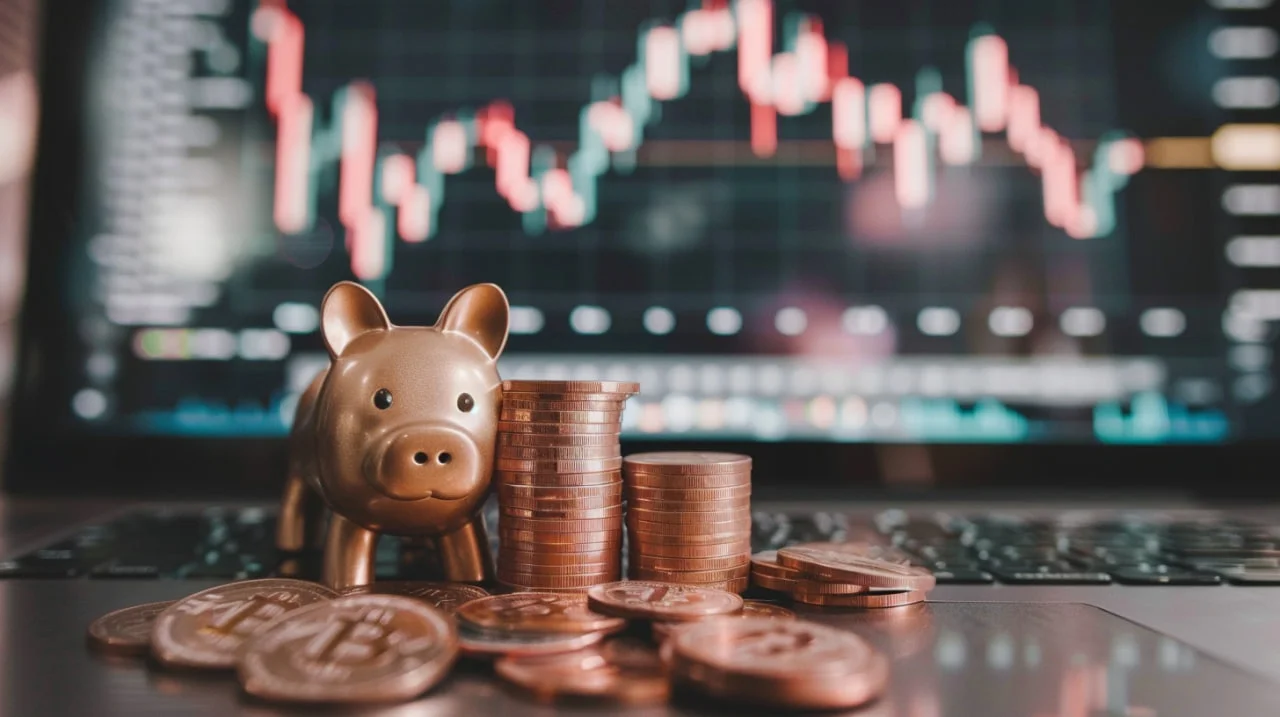
KEYTAKEAWAYS
- Day trading in crypto involves buying and selling digital assets within the same day, capitalizing on high volatility and 24/7 market access for potential quick profits.
- Successful crypto day trading requires understanding various strategies like trend following and breakout trading, while implementing strict risk management techniques.
- Emotional control and continuous learning are crucial for day traders. Starting small and using demo accounts can help beginners gain experience without significant risk.

CONTENT
What is day trading in the crypto market? Learn strategies, risks, and tips for successful cryptocurrency day trading. Perfect for beginners looking to understand short-term trading in digital assets.
If you’re new to the world of crypto and find yourself asking, “What is day trading?”, you’ve come to the right place. This comprehensive guide will walk you through the essentials of crypto day trading, providing you with the knowledge needed to understand and navigate this dynamic and challenging field.
DEFINING DAY TRADING IN THE CRYPTO MARKET
At its core, day trading involves buying and selling digital assets within the same trading day. Unlike long-term investors who might hold assets for months or years, day traders aim to profit from short-term price fluctuations, often entering and exiting positions within hours or even minutes.
What makes crypto day trading unique are the inherent characteristics of the market:
✅ Extreme Volatility: Prices can change dramatically within short periods, creating opportunities for traders but also presenting high risks. For instance, Bitcoin has been known to fluctuate by 10% or more in a single day.
✅ 24/7 Market: Unlike traditional stock markets, the crypto market operates around the clock, requiring traders to be ready to act at any time. This non-stop nature can lead to increased stress and potential burnout if not managed properly.
✅ Decentralized Nature: The lack of central control means less regulation, but it also makes the market more susceptible to manipulation and external factors. News, tweets from influential figures, or regulatory announcements can cause sudden market shifts.
Understanding these characteristics is key to grasping what day trading is in the context of crypto. The combination of these factors creates a unique trading environment that offers high potential rewards but also significant risks.
Day traders in the crypto market need to be particularly adept at quick decision-making and have a high tolerance for risk. They must also be comfortable with technology, as most trading is done through digital platforms and often involves the use of trading bots and algorithms.
>>> More to read : 4 Easy Ways to Master Crypto Day Trading

BASIC STRATEGIES IN CRYPTO DAY TRADING
After understanding what day trading is, it’s crucial to explore some commonly used strategies. Each strategy has its own risk profile and requires different skills and market conditions to be effective.
📌 Basic Strategy 1: Trend Trading
This strategy involves following the current price momentum. For example, if Bitcoin’s price is on an upward trend, a trend trader might buy in anticipation of further increases. The key to successful trend trading is identifying the trend early and having the discipline to exit when the trend shows signs of reversal.
📌 Basic Strategy 2: Counter-trend Trading
This approach involves betting on price reversals, taking opposite actions when the market is overbought or oversold. It’s a riskier strategy that requires a keen eye for market dynamics and strong nerves. For instance, if Ethereum has seen a sharp price increase over a short period, a counter-trend trader might short-sell, anticipating a correction.
📌 Basic Strategy 3: Arbitrage Trading
This strategy capitalizes on price differences across different exchanges. For example, if Bitcoin is trading at $30,000 on Exchange A and $30,100 on Exchange B, an arbitrage trader would buy on A and immediately sell on B for a quick profit. While this sounds simple, it requires quick execution and often sophisticated software to be profitable, as these opportunities can disappear in seconds.
📌 Basic Strategy 4: Scalping
This is a high-frequency trading strategy where traders make numerous trades within a day, aiming to profit from small price movements. Scalpers might hold positions for just a few seconds or minutes, making many small profits that add up over time.
For beginners, it’s crucial to start with small amounts and use demo accounts to practice these strategies. As you gain experience, you can gradually increase your involvement. Remember, what works for one trader may not work for another, so it’s important to find a strategy that fits your personality, risk tolerance, and lifestyle.
>>> More to read : Crypto Trading Strategies for Beginners

THE IMPORTANCE OF RISK MANAGEMENT IN DAY TRADING
Understanding what day trading is goes beyond just knowing strategies; it’s equally important to master risk management. Without proper risk management, even the most promising strategy can lead to significant losses.
Here are some key risk management principles:
- Use only 1-5% of your total funds for each trade: This rule helps ensure that no single trade can wipe out a significant portion of your capital.
- Set a maximum daily loss limit: Once this limit is reached, stop trading for the day. This prevents emotional decision-making that often leads to larger losses.
- Use stop-loss orders to limit potential losses: These automatic orders close your position if the price moves against you by a predetermined amount.
- Implement tiered position management: Allocate funds based on risk levels. For example, use larger portions of your capital for lower-risk trades and smaller portions for higher-risk opportunities.
- Seek favorable risk-reward ratios: Ideally, the potential profit should be at least twice the potential loss. This means that even if only 50% of your trades are successful, you can still be profitable overall.
Effective risk management is the cornerstone of long-term success in day trading. It helps protect your capital in volatile markets, providing a foundation for sustained trading.
An often overlooked aspect of risk management is portfolio diversification. While day trading typically involves quick in-and-out trades, maintaining a diversified portfolio can help mitigate risks associated with any single crypto or market sector.
>>> More to read : Best Crypto Trading Course for Free in 2024
THE PSYCHOLOGY BEHIND SUCCESSFUL DAY TRADING
A critical aspect of mastering what day trading is involves understanding and managing trading psychology. The high-pressure environment of day trading can trigger strong emotional responses that affect decision quality.
Here are some common psychological traps and strategies to deal with them:
1️⃣ Common psychological traps:
- Confirmation bias: Seeking only information that supports your views, which can lead to overlooking important contrary indicators.
- Sunk cost fallacy: Reluctance to exit losing trades due to the resources already invested, often resulting in larger losses.
- Overconfidence: Becoming blindly optimistic after a series of successes, which can lead to excessive risk-taking.
- Fear of missing out (FOMO): Making impulsive trades based on market hype rather than solid analysis.
2️⃣ Coping strategies:
- Practice mindfulness techniques to stay calm and focused. Regular meditation can improve emotional regulation and decision-making under pressure.
- Keep an emotional trading journal to analyze decision patterns. This can help identify emotional triggers and improve self-awareness.
- Develop and stick to a trading plan. Having predetermined entry and exit points can help remove emotion from trading decisions.
- Use the “10-minute rule” – if you’re unsure about a trade, step away for 10 minutes before making a decision. This can help prevent impulsive actions.
By recognizing these psychological factors and actively managing emotions, you can improve your overall performance as a day trader. Remember, successful trading is as much about mindset as it is about market knowledge.
>>> More to read : How to read crypto charts: A beginner’s guide to market analysis

★ Continuous Learning and Choosing the Right Tools ★
Mastering what day trading is requires ongoing education and the right tools. The crypto market is constantly evolving, demanding that traders continually update their knowledge and skills.
✏️ When choosing a trading platform, consider the following factors:
➤ Liquidity: Higher liquidity means easier entry and exit from positions.
➤ Fee structure: Look for competitive fees to ensure they don’t eat into your profits.
➤ Security features: Given the prevalence of hacks in the crypto world, robust security is crucial.
➤ Available trading tools: Look for platforms that offer advanced charting, real-time data, and API access for algorithmic trading.
🔍 Methods for continuous learning include:
✔ Staying updated on market trends and news through reputable crypto news sites and social media channels.
✔ Learning and practicing technical analysis, including understanding various chart patterns and indicators.
✔ Engaging with trading communities to exchange experiences and strategies. However, always verify information and maintain independent thinking.
✔ Using trading simulators to practice new strategies without risking real money.
✔ Attending webinars, online courses, and crypto conferences to gain insights from experienced traders and industry experts.
As you progress, consider exploring more advanced topics such as:
- Algorithmic trading and the use of trading bots
- Advanced chart analysis techniques like RSI or other advanced techniques.
- Understanding market microstructure and order flow analysis
Remember, while communities can provide valuable insights, it’s crucial to maintain independent thinking and always do your own research (DYOR) before making trading decisions.
>>> More to read : What Is RSI, and How Do You Use It in the Crypto Market?
CONCLUSION: IS DAY TRADING RIGHT FOR YOU?
Now that you have a comprehensive understanding of what day trading is in the crypto environment, you can assess whether it aligns with your goals and risk tolerance. Day trading can be profitable but requires time, effort, and discipline.
🚩 Successful day trading requires:
- A deep understanding of the market and its dynamics
- Solid risk management skills and the discipline to stick to your rules
- Strong emotional control and the ability to make decisions under pressure
- A commitment to continuous learning and adapting to market changes
- Technological proficiency and the ability to use various trading tools effectively
It’s important to note that while day trading can be exciting and potentially lucrative, it’s not suitable for everyone. The high-stress environment and potential for significant financial losses can be overwhelming for many individuals. Moreover, studies have shown that a large percentage of day traders end up losing money, especially in their first year.
If you decide to pursue day trading, start small, focus on learning, and always prioritize risk management. Consider starting with paper trading (simulated trading with no real money at stake) to practice your strategies and gain confidence before risking real capital.
Alternatively, if you find that the intensity of day trading doesn’t suit you, there are other ways to participate in the crypto market. These include long-term investing (often called “HODLing” in crypto parlance), swing trading (holding positions for days or weeks), or investing in crypto-focused funds or companies.
With the right approach, education, and attitude, you can find your path in the world of crypto trading, whether that’s as an active day trader or in another capacity. Remember, the key to success in any form of trading or investing is continuous learning, disciplined risk management, and a clear understanding of your own goals and limitations. Wishing you success in your crypto journey!
>>> Learn more:
What Is Crypto Trading? What Investors Need to Know
Crypto Spot Trading vs. Future Trading: Which is Best for You?
4 Trusted Crypto Market Live Trackers for Staying on Trend
TOP 5 Crypto Trading Platforms April 2024
4 Best Crypto Trading Tools for Success in 2024
Copy Trading Crypto Like a Pro on Bitget

















